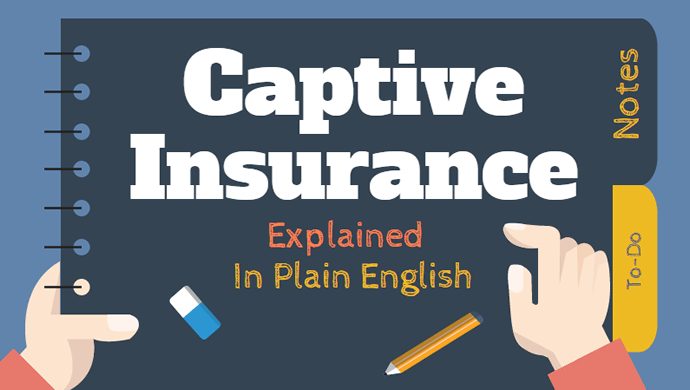
Research shows that about 80% of the Standard and Poor 500 (S&P 500) companies own one or more captive insurance companies. Offshore captive insurance is the main source of insurance for both large and small companies. U.S. Internal Revenue Code Section 831(b) specifically allows for a particular type of insurance where the insurance company is owned by the shareholders or principals of the insured company. The insured, related company which pays the premiums into the plan is allowed a tax deduction for the premiums as an ordinary and necessary business expense.
Captive Insurance Tax Benefits
The company paying the premiums receives a tax deduction, and the captive insurance company receiving the premiums receives the first $2.2 million tax-free. The statutory captive insurance company will elect to be classified as a domestic insurance company as indicated under IRC Section 953(d). It will, therefore, file US tax returns annually. However, premium income up to the first $2.2 million is exempt from taxation. In the following calendar year, another $2.2 million can be contributed, for a total of $4.4 million over two years, $6.6 million in premiums are tax deductible over three years, etc.
Captive Insurance Definition
A captive is an insurance company that insures the risk of its parent company. Laymen may refer to the arrangement as self-insuring, alternative risk transfer or alternative insurance.
Real Insurance
In order to pass the sniff test, it is essential that captive insurance company provides real insurance. It can insure your own businesses. However, it is not a tax loophole disguised as an insurance company. So, there are guidelines that the IRS requires, some of which we discuss below.
For example, to comply with IRS requirements, the captive insurance company premiums need to exceed investment income. Additionally, the policies that the captive issues need to comply with the “risk distribution” and “risk shifting” requirements. In order to comply, the company can obtain reinsurance. This is done in the international reinsurance markets whereby “pooling” arrangements are utilized. Doing so can successfully minimize the costs and the help to protect against to claims by unrelated companies. The finer points and investments required to establish and maintain the entities depend on the needs and desired outcomes.
Additional Benefits
Financial havens with strong insurance statutes are the locations where most companies are formed. In addition to the tax benefits describe above there are several additional convincing reasons why captive offshore insuring vehicle should be considered. One is able to “self insure” to an extent not available otherwise. The cost of insurance can be significantly reduced. Plus, risk management is enhanced. Moreover, if a standard policy is not available or extraordinarily expensive, the plan may be the only viable option. Professional malpractice, pollution and hazardous materials as well as catastrophic risk are excellent examples of rates-gone-awry. US insuring companies frequently raise rates or deny coverage without warning. Whereas, owning your own offshore captive company can give your plan longstanding solidity and direct access to reinsurance markets.
Domestic vs. Offshore
There are some US states and at least one Canadian province with statutes on the books that enable domestic captives. However, there are particularly attractive benefits to going offshore. These include lower costs, possible tax benefits and increased flexibility.
Investing Premiums
The money inside the insurance company is, in turn, invested. One popular and stable choice is to invest the money with a Swiss bank account that has a money management division. Whereas the premiums are deductible and the company receives premiums tax-free, naturally, income that is generated from the investment activity is taxed annually.
Types of Captive Insurance Companies
A captive is a wholly owned subsidiary of a company that is not primarily in the insurance industry. Its main function is to insure some or all of the risk of its parent company. As the industry has grown those involved have sought new methods of enhancing the captive structure to create means by which a variety of industries can benefit. Here are a number of different structures a are being used;
- Single Parent Captives – Only underwrite the risk of related group companies.
- Diversified Captives – Underwrite unrelated risk in addition to related group companies.
- Association Captives – Underwrite the risk of members of a specific industry-type or trade-association. Medical malpractice is often insured in this fashion.
- Rent-A-Captives – Companies that offer access to captive structures without needing to establish one’s own insurance company. The participant pays for the use of the company and needs to provide collateral so that the rent-a-captive is not exposed to substantial risk experienced by the participant.
- Special Purpose Vehicles (SPV’s) – Used to secure risk. These are reinsurance companies that execute contracts with their parent company and yield the risk to risk the capital markets. This is typically accomplished by a bond issue.
- Agency Captives – Established by insurance agents or brokers to enable them to participate only in low-risk activities under their control.
Requirements
Accounting
Because this technique is common among many well-know companies, there are a number of highly regarded accounting firms that deal with the necessary tax and reporting duties for statutory captives.
Not a Listed Transaction
The IRS has issued Notice 2004-65 which has successfully de-listed the Section 831(b) statutory captive insurance company as a tax shelter. So, it is not a listed transaction and the IRS does not require special notification that one is participating in such a program. IRS Commissioner Mark. W. Everson has states, “Based on disclosures from taxpayers and examination of tax returns, we have determined problems associated with these transactions are not as prevalent as initially believed. Accordingly we are no longer classifying them as listed transactions.”
Then IRB 2016-47 further clarified micro-captive transactions. It gives a brief background. Further, the bulletin discusses transitions of interest and rules of application.
Each jurisdiction has different minimum capitalization requirements. That is, a minimum amount of liquid capital that the jurisdictions requires before it can obtain a license. Since the capitalization is not deductible, the lower the better. See Captive Insurance Minimum Capital and Surplus Requirements by jurisdiction.
Conclusion
Offshore captive insurance offers some significant benefits to many companies, including small to large Fortune 500 firms. To form a captive insurance company, use the number or inquiry tool that is located on this page.
This purpose of this page is to give a general overview of the subject matter. It involves complex legal and tax planning knowledge. We do not intended to give nor should you consider this page as tax or legal advice.





